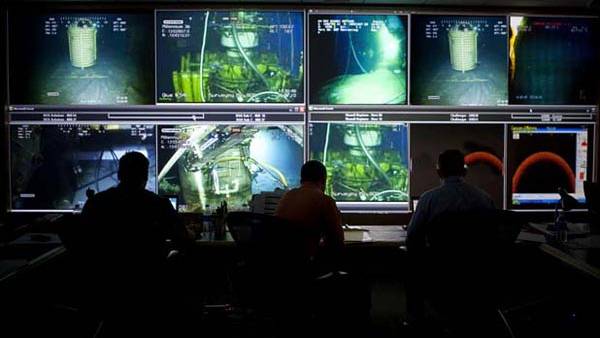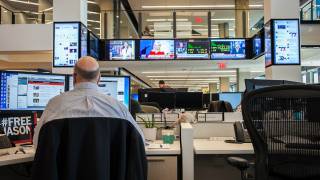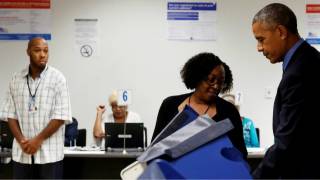BP digitally alters press photo, confesses it’s a fake
Source: msnbc.msn.com
 It’s been a long season of embarrassment for BP, but leaking oil isn’t what the blogosphere is ripping the company for today. A site called Americablog spotted a press photo of BP’s Houston command center, ostensibly taken on July 16. The image had quite visibly been Photoshopped — badly — to include more on-screen camera action.
It’s been a long season of embarrassment for BP, but leaking oil isn’t what the blogosphere is ripping the company for today. A site called Americablog spotted a press photo of BP’s Houston command center, ostensibly taken on July 16. The image had quite visibly been Photoshopped — badly — to include more on-screen camera action.Once word got out — the story was picked up by the Washington Post, where it was then spotted by the tech blog Gizmodo and others — BP ’fessed up. A spokesman admitted that the image was altered, said that a photographer had inserted shots where the TV screens were blank, and provided the original image.
"We’ve instructed our post-production team to refrain from doing this in the future," said the spokesman in an e-mail to the Washington Post.
Though the command center alteration doesn’t seem to be an attempt to hide facts or confuse the public, it heightens skepticism for the company at a time when it should be trying to build trust. As the Americablog reporter John Aravosis wrote, "I guess if you’re doing fake crisis response, you might as well fake a photo of the crisis response center."
As it happens, the command center shot isn’t the end of the issue. Today, Aravosis published evidence of another altered press photo, this one depicting a meeting from the failed "top kill" maneuver. "How many other crisis response photos from BP have been faked?" wrote Aravosis. "Did they fake any videos?"
Please don’t tell us that the people in those sucking-it-up-and-taking-responsibilty ads are actually paid models!
Article from: msnbc.msn.com
Why Would BP Photoshop Its Crisis Command Center?
By Carl Franzen | AOLNews.com
BP’s public image problems took a turn for the weirder on Monday, with AMERICAblog’s John Aravosis exposing a poorly doctored photo of the company’s crisis command center in Houston that had been posted to the official crisis response website. The company has now come clean (sort of) to The Washington Post -- claiming this morning that it was the photographer who snapped the image who was responsible for inserting three extra video screens into a bank of monitors. It still remains unclear, though, precisely why the alterations were even made in the first place.
Check out the differences for yourself. First up, the Photoshopped image as it originally appeared on BP’s website:
HIVE at Houston Command Center, July 16, 2010. (BP LLC) ALTERED IMAGE
Next, the updated image posted last night, purportedly unaltered, which shows three blank ROV screens in place of the underwater images that had been pasted into the original photo.
HIVE at Houston Command Center, July 16, 2010. (BP LLC) ORIGINAL IMAGE
"Normally, we only use Photoshop for the typical purposes of color correction and cropping," BP spokesman Scott Dean told the Post in an e-mail. "In this case, they copied and pasted three ROV screen images in the original photo over three screens that were not running video feeds at the time."
BP’s remote-operated vehicles (ROVs), or robot submarines, have played crucial roles in the response to the gulf oil spill crisis since it began, sending back video and still images of the scene around the well and operating the various proposed mechanical solutions for containing the leak a mile below the surface, where no human divers can work.
However, BP has been criticized for suppressing damning underwater video footage from the public -- specifically, footage that showed much more serious leaks than the company was admitting to during the days immediately following the Deepwater Horizon platform explosion on April 20.
In this case, the company, or someone employed by it, seems to have made the opposite error -- supplying extra views where there were none. Why would BP or the photographer do so? Bloggers have proposed several theories.
1. The Photo Was Too Old
As one of AMERICABlog’s readers pointed out, "The photo contains data suggesting it was taken in 2001, not July of 2010 as claimed on BP’s website. That would suggest at least one possibility is that BP took an old photo and Photoshopped new pictures of the oil spill over it, to make it look ’new.’" The company has not addressed this speculation, and the meta data for the updated photo contains a time stamp from July 16.
2. BP Feared the Blogosphere
Gawker’s Max Read wonders if BP was hoping to avoid further public criticism for posting a photo showing blank video screens. "Were they so afraid of the withering comments of bloggers noticing three blank screens that they thought they should paste in three duplicate images?" If so, the mission failed.
3. BP Just Doesn’t Care
EnergyBoom’s Nathanael Baker offers one of the most cynical interpretations yet, saying that the faked photo is just further evidence of the company’s unrepentant audacity. "With all the public scrutiny surrounding BP, it is absolutely amazing that the company not only continues to make such poor public relations decisions, but also continues to offer misinformation to the world."
4. BP Responds: Combination of Good Intentions Gone Bad, Technical Glitches
UPDATED: BP spokesperson Scott Dean told Surge Desk that the photo was altered in post-production by the photographer and a team of editors, to make the scene "more panoramic," but that it was a mistake and that the company has not and will not be doing any similar adjustments.
When asked if there are other photos currently on the website that have undergone similar Photoshop treatments, Dean said that "some have undergone color-correction and cropping, but that’s generally the extent. We’re currently looking through and reviewing all of the other photos to make sure nothing like this has happened anywhere else. It’s certainly not a routine practice."
Read the full article at: AOLNews.com






















